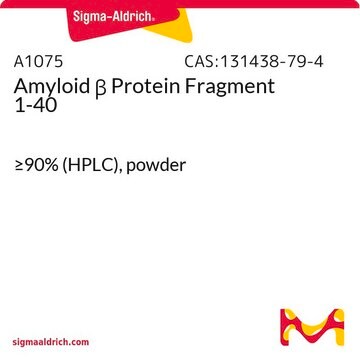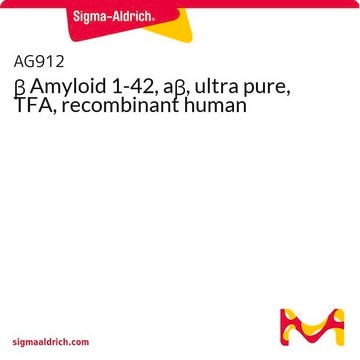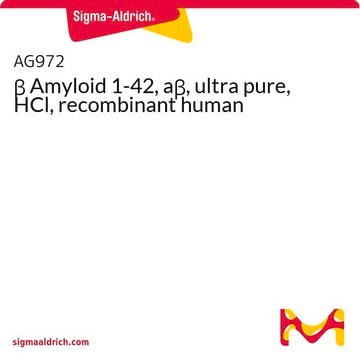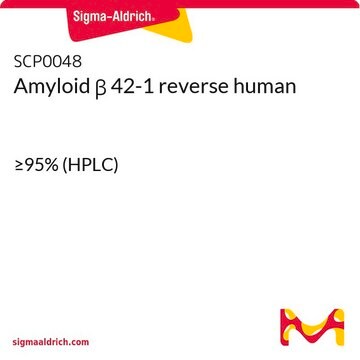AG968
β Amyloid 1-42, aβ, ultra pure, HFIP, recombinant human
Sign Into View Organizational & Contract Pricing
All Photos(1)
About This Item
UNSPSC Code:
12352202
eCl@ss:
32160405
NACRES:
NA.41
Recommended Products
biological source
human
Quality Level
Assay
>97.0%
form
powder
manufacturer/tradename
Chemicon®
NCBI accession no.
UniProt accession no.
Gene Information
human ... APP(351)
General description
β Amyloid 1-42 is a derivative of integral membrane-bound amyloid precursor protein. It is the most important alloform of the Alzheimer′s peptide.
Application
β Amyloid 1-42, aβ, ultra-pure, HFIP, recombinant human has been used:
- to study its effect on the activity of mitochondrial BKCa (mitoBKCa) channels in human astrocytoma cells through patch-clamp technique
- to study its effect on alteration in protein levels of dystrophic neurites (DNs) forming proteins in mouse neuroblastoma cells
- to induce Alzheimer′s disease in a rat model for experimental studies
Biochem/physiol Actions
β Amyloid 1-42 causes neurotoxicity and is implicated in the pathogenesis of Alzheimer′s disease (AD). β Amyloid (βA) acts as a ligand for several receptors and other molecules involved in complex trafficking pathways in tissues and blood-brain barriers. βA along with amylin elevates cyclic adenosine monophosphate (cAMP) and Ca2+ in turn activates multiple signaling pathway mediators like mitogen-activated protein kinase (MAPK), protein kinase A/B, and cFOS. It acts as the main source of AD-associated neuroinflammation.
Legal Information
CHEMICON is a registered trademark of Merck KGaA, Darmstadt, Germany
Storage Class Code
13 - Non Combustible Solids
WGK
WGK 1
Flash Point(F)
Not applicable
Flash Point(C)
Not applicable
Certificates of Analysis (COA)
Search for Certificates of Analysis (COA) by entering the products Lot/Batch Number. Lot and Batch Numbers can be found on a product’s label following the words ‘Lot’ or ‘Batch’.
Already Own This Product?
Find documentation for the products that you have recently purchased in the Document Library.
Customers Also Viewed
Annika Olsson et al.
Clinical chemistry, 51(2), 336-345 (2004-11-26)
To simultaneously study several biomarkers for Alzheimer disease (AD), we used the xMAP technology to develop and evaluate a multiparametric bead-based assay for quantification of beta-amyloid((1-42)) [Abeta((1-42))], total tau (T-TAU), and hyperphosphorylated tau [P-TAU((181P))] in cerebrospinal fluid (CSF). We compared
Stephanie J Soscia et al.
PloS one, 5(3), e9505-e9505 (2010-03-09)
The amyloid beta-protein (Abeta) is believed to be the key mediator of Alzheimer's disease (AD) pathology. Abeta is most often characterized as an incidental catabolic byproduct that lacks a normal physiological role. However, Abeta has been shown to be a
Ye Ji Lee et al.
Frontiers in molecular neuroscience, 16, 1150399-1150399 (2023-05-05)
Growth-associated protein 43 (GAP-43) is known as a neuronal plasticity protein because it is widely expressed at high levels in neuronal growth cones during axonal regeneration. GAP-43 expressed in mature adult neurons is functionally important for the neuronal communication of
Mohabbat Ahmadi et al.
Avicenna journal of phytomedicine, 9(5), 465-473 (2019-09-14)
Zataria multiflora (ZM) is a plant with ethnopharmacological value which was recently tested to reduce symptoms of Alzheimer's disease (AD). The aim of the present study was to determine the effect of ZM essential oil on spatial cognitive and noncognitive
Xiao Hu et al.
Neuro-degenerative diseases, 21(5-6), 117-125 (2022-03-11)
Alzheimer's disease (AD) is the most frequent cause of dementia among the elderly. The accumulation of amyloid beta (Aβ) and its downstream pathological events such as oxidative stress play central roles in AD. Recent studies revealed that Aβ oligomer (AβO)-induced
Our team of scientists has experience in all areas of research including Life Science, Material Science, Chemical Synthesis, Chromatography, Analytical and many others.
Contact Technical Service










